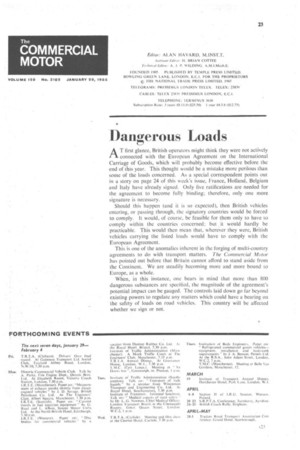Dangerous Loads
Page 25

If you've noticed an error in this article please click here to report it so we can fix it.
A T first glance, British operators might think they were not actively connected with the European Agreement on the International Carriage of Goods, which will probably become effective before the -end of this year. This thought would be a mistake more perilous than some of the loads concerned. As a special correspondent points out in a story on page 24 of this week's issue, France, Holland, Belgium and Italy have already signed. Only five ratifications are needed for the agreement to become fully binding; therefore, only one more signature is necessary.
Should this happen (and it is so expected), then British vehicles entering, or passing through, the signatory countries would be forced to comply. It would, of course, be feasible for them only to have to comply within the countries concerned: but it would hardly be practicable. This would then mean that, wherever they were, British vehicles carrying the listed loads would have to comply with the European Agreement.
This is one of the anomalies inherent in the forging of multi-country agreements to do with transport matters. The Commercial Motor has pointed out before that Britain cannot afford to stand aside from the Continent. We are steadily becoming more and more bound to Europe, as a whole.
When, in this instance, one bears in mind that more than 800 dangerous substances are specified, the magnitude of the agreement's potential impact can be gauged. The controls laid down go far beyond existing powers to regulate any matters which could have a bearing on the safety of loads on road vehicles. This country will be affected whether we sign or not.




















































































































